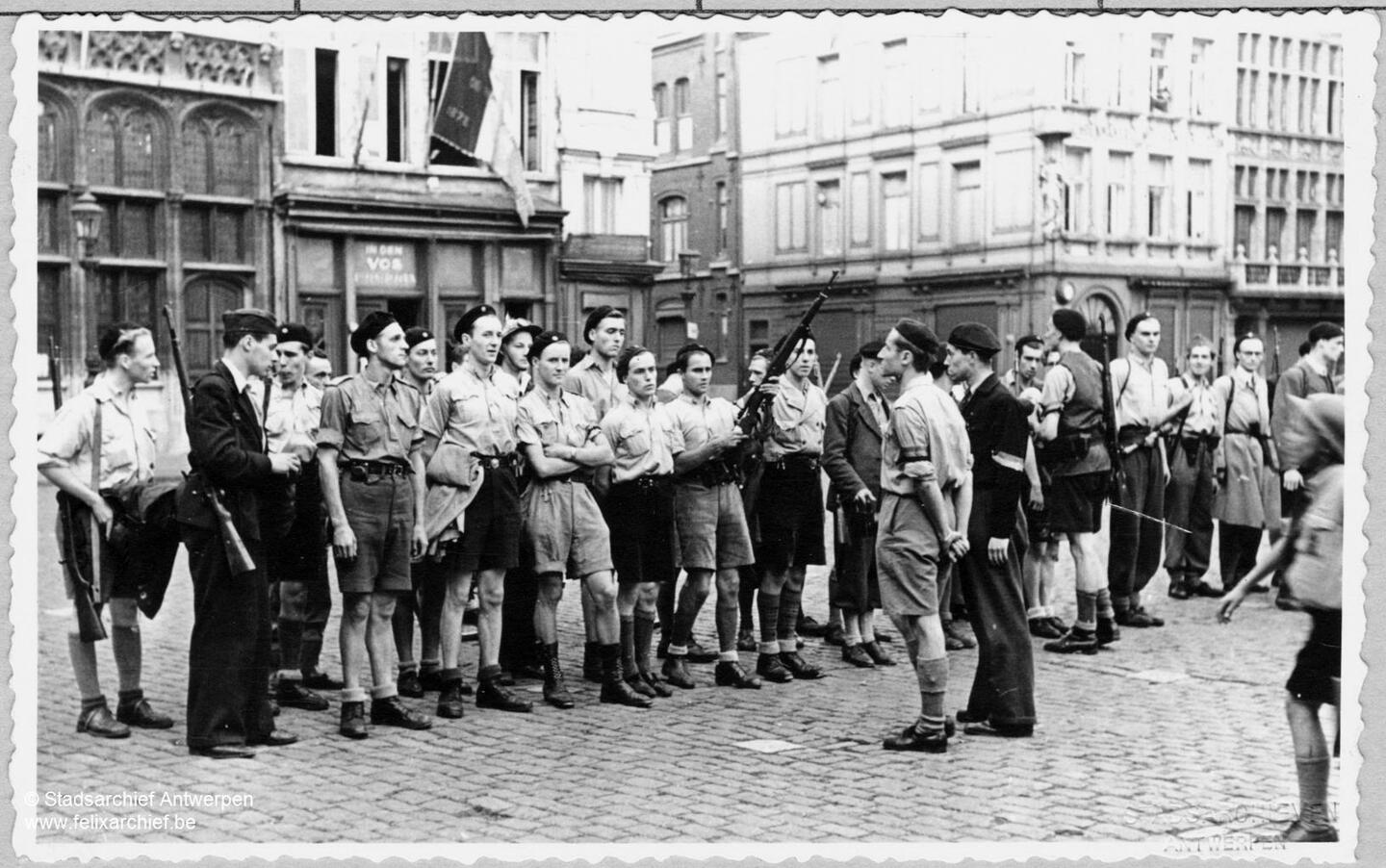Antwerp’s resistance movement
When the Germans occupied Antwerp in May 1940, many people resigned themselves to the situation. Some Antwerpians were less inclined to do so. They sprang into action, fuelled by patriotic and anti-fascist motives, often bolstered by pro-English or communist sympathies, a sense of solidarity or a desire for justice. There were various ways to support the resistance effort, including spreading propaganda, gathering intelligence, assisting those who were targeted by the occupying forces, and sabotage. In the early years of the war, the resistance movement was small. From autumn 1942, the movement swiftly grew as hostility against the Nazis increased and victory loomed on the horizon.
Although people could make an individual contribution, many decided to join organised groups. A wide range of resistance organisations and clandestine networks operated out of Antwerp. They included the Nationale Koninklijke Beweging (National Royal Movement), the Geheim Leger (Secret Army), the Onafhankelijkheidsfront (Independence Front), Groep G (Group G), the Belgische Nationale Beweging (Belgian National Movement) and the Witte Brigade (White Brigade). Interestingly enough none of these organisations were originally founded in Flanders. The resistance effort was far more pronounced in the south of the country. There are several explanations of this, including the sympathetic attitude of the German military administration towards the Flemish population. Patriotic and anti-fascist sentiment, which served as a breeding ground for the resistance movement, was also poorly developed in this region. The White Brigade was the notable exception to this rule. This resistance group was founded in June 1940 in Antwerp. The movement further developed during the war under the leadership of its founder, Marcel Louette. Gradually the organisation gained a foothold outside of Antwerp.
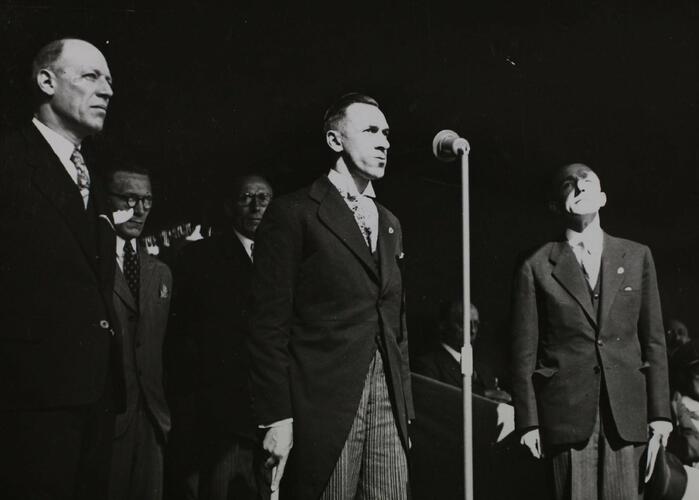
Marcel Louette, founder and national commander of the White Brigade. (© Antwerp City Archives)
Keistraat
Marcel Louette (b. 24/02/1907) was a teacher in the community college in Keistraat in Antwerp. He was a member of several liberal associations, such as Diesterweg and Jonge Geuzenwacht. He was the president of the latter organisation from 1934 onwards In September 1939, Louette’s life changed radically when he received word that he might be conscripted. He eventually participated in the Eighteen Day Campaign as a commander. The German army briefly imprisoned Louette in Ronse but he succeeded in returning to Antwerp. For Louette, there was only one option. He refused to resign himself to the Germany victory. Initially he decided to join the Allied armies in France but when the French army capitulated on 22 June, Louette changed tack. Belgium and Northern France were already occupied by then. Louette realised that the fight against Nazi Germany would take place on Belgian soil. He tentatively started to reach out to allies. He found a few like-minded people here and there but for the most part - and much to his surprise - people remained largely indifferent.
Breydelstraat
On 23 June 1940, Jonge Geuzenwacht organised a meeting in Café Sportman in Breydelstraat. Everyone present agreed that they had no option but to actively resist the German usurpers. This marks the symbol start of what would later become the White Brigade resistance movement. The first members were Maria Michiels, Louette’s foster daughter, and Leon Boumans, the vice-president of Jonge Geuzenwacht. Together with Louette, they succeeded in finding another twenty supporters that first month. The group mainly consisted of members of Jonge Geuzenwacht, soldiers who served under Louette and a handful of colleagues from the school in Keistraat. The group steadily grew as friends and family joined and soon included members of Antwerp’s police force and dock workers.
Soon after its foundation, the organisation already had branches in other cities.
Local branches were also founded in Brussels, Ghent, Leuven and smaller Flemish cities. From 1943, the White Brigade was also operating in Wallonia. The first year, the resistance group continued to operate under the ‘Jonge Geuzenwacht’ name. It wasn’t until 1941 that they were called the White Brigade. The name was coined in response to the collaborationist Dietsche Militia or Black Brigade, the party army of the Vlaams Nationaal Verbond (VNV), which wore black uniforms. After the war, public opinion thought that the White Brigade was a collective name for all local resistance groups. To distinguish itself from the others, the organisation changed its name to ‘Witte Brigade/Fidelio’, adding Marcel Louette’s pseudonym.
Vleeshuis/The Butcher’s Hall
The White Brigade developed into an agile organisation with a wide range of resistance activities.
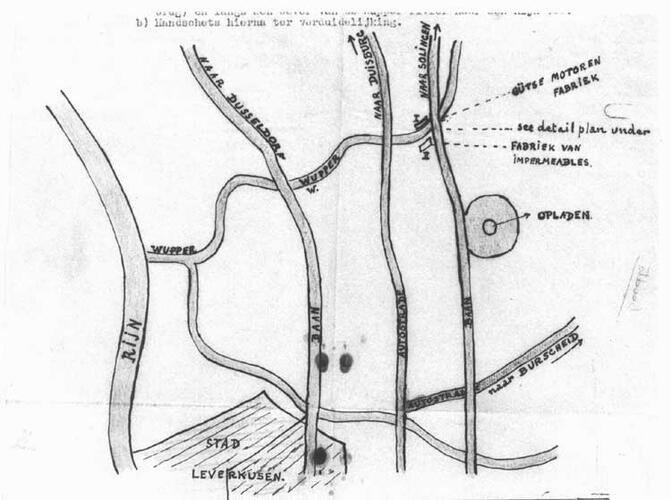
Part of a map to be used as intelligence by the Allies in London.
The map shows the location of a German factory. (in: Witte Brigade (Fidelio) 1940-1944, J. P. Arnolds e.a., Antwerp, 1990)
One of the first undertakings of Louette and his allies consisted of translating and distributing clandestine media. Initially they published the broadsheets of other resistance groups. In 1941, they launched their own, publishing ‘Steeds Vereenigd – Unis Toujours’ after the Sipo-SD arrested the broadsheet’s founders. Gathering intelligence was another priority. Members passed on valuable information about the German occupying forces to the Allies in London. Initially they used couriers for this. They later switched to radio communications. While this was much easier, it was not without risk. Like so many other resistance groups, the White Brigade also tried to sabotage the Germans. A weapons depot was set up in the Butcher’s Hall for this purpose. Over time, this historic building became the organisation’s headquarters in Antwerp. The members also assisted people in need. They helped Jews, Allied soldiers and volunteers for the Belgian army escape to London. People who decided to go into hiding in the city received aid in the form of cash and food stamps.
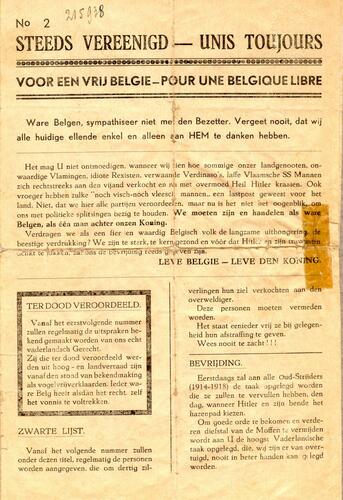
Issue of Steeds Vereenigd – Unis Toujours published by the Deurne branch. (from the collections of the Hendrik Conscience Heritage Library)
A large network of committed resistance fighters specialised in one or more of these activities.
From the outset, it became clear that they needed a method to keep the identities of their members secret and prevent mass arrests. Initially people resorted to pseudonyms, but this system soon proved very complicated. Marcel Louette then devised a method whereby every member was assigned a number. Numbers that started with a 0 were given to members who were in direct contact with Louette. His sidekick Maria Michiels was given the number 01. Louette also introduced a chain system. The members passed on information and news to each other through a chain, whereby one member passed on information to another. This person then became the liaison for the next person in the chain. This ensured that a resistance member only knew the number and address of the person that came next in the chain. This prevented people from disclosing the names of other members in the event of their arrest.
Cuylitsstraat
During the early war years, the White Brigade largely escaped arrest. From 1942 onwards, the situation changed. On 23 July, the inevitable happened: Marcel Louette was forced to go into hiding.
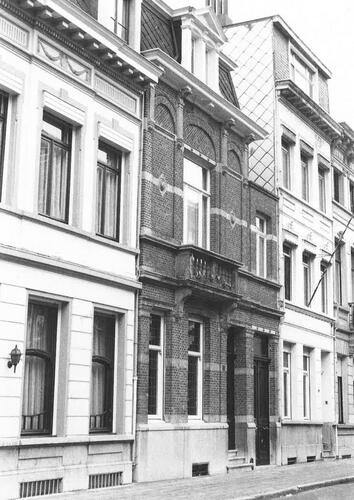
House at no. 31, Cuylitsstraat, where Marcel Louette went into hiding from 1942 until 1944.
(in: Witte Brigade (Fidelio) 1940-1944, J. P. Arnolds e.a., Antwerp, 1990)
When Gestapo officers arrived at the school in Keistraat to arrest him, Marcel Louette realised that the time had come to go into hiding. He moved all the documents from his home to the Butcher’s Hall. He then headed to 31, Cuylitsstraat where the Peeters family lived. They were prepared to give him a place to hide. A few months later, in December 1942, several members of the organisation were arrested. This was the consequence of previous actions targeting the Independence Front. Until 1944, the organisation suffered several setbacks. It is estimated that one third of the active members ended up being arrested by the Gestapo, including the majority of the organisation’s leaders. One month after Louette was arrested, the occupying forces captured his successor, Frans Hellemans. Founding member Leon Boumans was also arrested.
Koningin Elisabethlei
Louette had been staying at the same hideout since 1942, despite warnings from friends and supporters. Two years later, the situation deteriorated. In 1944, the Germans arrested his parents and wife. On 9 May, Marcel Louette was arrested. That morning, the Gestapo raided the house in Cuylitsstraat. They captured Louette, along with Mrs Peeters, her daughters and her son-in-law. Louette was first taken to the Gestapo headquarters in Koningin Elisabethlei to be interrogated. After a long and torturous journey, with Louette spending time in the prison of Saint-Gilles and Fort Breendonk, he was sent to a concentration camp in Vught, the Netherlands. Louette was then sent to Sachsenhausen-Oranienburg.
Stuivenberg Hospital
From the outset, the White Brigade worked towards one single goal, the Hour H, the country’s liberation. When the time finally came, the organisation’s wings had been clipped to such an extent that it was unable to play any part in the liberation. The ranks of the White Brigade had been whittled down. Several sectors were only able to re-establish contact after the war. In September 1944, Marcel Louette, the organisation’s national commander, was still in captivity. Vital Bosschaerts thus took over as leader during and after the liberation. The Red Army finally freed Marcel Louette on 22 April 1945 when they entered the camp at Sachsenhausen. Upon his return, Louette, who had been beaten up repeatedly, spent several months recovering in Stuivenberg Hospital. He only resumed his duties as leader of the White Brigade much later. During the following years, Louette remained committed to those who had fought and suffered during the war. He fought for their recognition and social support they needed. He also served as president of various war associations.
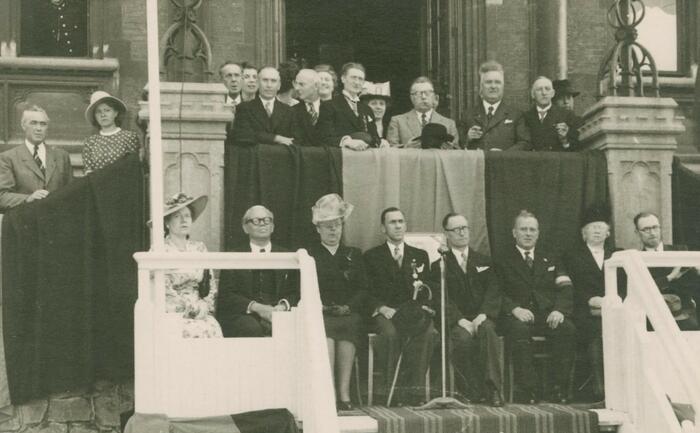
Reception for Marcel Louette in 1946. Louette is seated in the front row, fourth from the left. (© Antwerp City Archives)
Read the story of Pierre Coeck
Police officer Pierre Coeck joined the White Brigade as part of the Antwerp resistance effort during World War II.
In May 1944, the Sipo-SD arrested him in his home. His children managed to hide any incriminating material just in time. After spending several weeks in the prison in Begijnenstraat, Pierre was deported to Buchenwald. He returned to Belgium after a year of hardship. The story of his arrest and interrogation in the spring of 1944 was reconstructed based on Pierre’s memoires and the memories of his son René. You can find the article here.
Cegesoma
CegeSoma manages the archives of the White Brigade. Consider visiting them if you want to know more about the history of this resistance group.
Click here for more information: https://www.cegesoma.be/nl/achieven-van-de-witte-brigade

